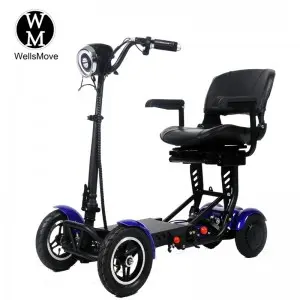Mobility Scooter Battery Options: Varying Types for Different Needs
When it comes to mobility scooters, the choice of battery can significantly impact performance, range, and overall user experience. Let’s delve into the various battery options available for mobility scooters and understand their unique characteristics.
1. Sealed Lead Acid (SLA) Batteries
Sealed Lead Acid batteries are traditional and known for their reliability and durability. They are maintenance-free, requiring no watering or acid level checking, and are relatively inexpensive compared to other types
1.1 Gel Batteries
Gel batteries are a variant of SLA batteries that use a thick gel electrolyte instead of liquid acid. This gel provides additional protection against vibration and shock, making them ideal for mobility scooters. They also have a slower self-discharge rate, allowing them to retain their charge for longer periods when not in use
1.2 Absorbent Glass Mat (AGM) Batteries
AGM batteries use a fiberglass mat to absorb the electrolyte, offering higher stability and preventing acid leakage. They are known for their low internal resistance, which allows for efficient energy transfer and quicker recharging times
2. Lithium-ion Batteries
Lithium-ion batteries are gaining popularity due to their high energy density and lightweight design. They offer longer ranges and higher power output compared to SLA batteries, making them a preferred choice for those requiring extended mobility
2.1 Lithium Iron Phosphate (LiFePO4) Batteries
LiFePO4 batteries offer enhanced safety features, being less prone to thermal runaway and having a longer lifespan. They also have a high charge and discharge rate, allowing for faster acceleration and better performance on inclines
2.2 Lithium Nickel Manganese Cobalt Oxide (LiNiMnCoO2) Batteries
Known as NMC batteries, they provide a balance between power output and capacity, suitable for various mobility scooter applications. NMC batteries also have a relatively fast charging time, reducing downtime for users
2.3 Lithium Polymer (LiPo) Batteries
LiPo batteries are lightweight and compact, offering design flexibility due to their shapeability. They deliver a consistent power output and are suitable for those requiring quick acceleration and sustained performance
3. Nickel-cadmium (NiCd) Batteries
NiCd batteries were once popular due to their durability and ability to handle extreme temperatures. However, they have been largely replaced due to environmental concerns associated with cadmium and lower energy density
4. Nickel-metal Hydride (NiMH) Batteries
NiMH batteries offer higher energy density than NiCd batteries, resulting in longer operating times. However, they suffer from memory effect, where their capacity decreases if not fully discharged before recharging
5. Fuel Cell Batteries
Fuel cell batteries use hydrogen or methanol to produce electricity, offering long operating times and quick refueling. However, they are relatively expensive and require refueling infrastructure
5.1 Hydrogen Fuel Cell Batteries
These batteries generate electricity through a chemical reaction with hydrogen gas, producing zero emissions and offering a longer range
5.2 Methanol Fuel Cell Batteries
Methanol fuel cell batteries generate electricity through a reaction between methanol and oxygen, offering higher energy density and longer operating times
6. Zinc-air Batteries
Zinc-air batteries are known for their long life and low maintenance, but they are not commonly used in mobility scooters due to their specific requirements and handling needs.
7. Sodium-ion Batteries
Sodium-ion batteries are an emerging technology that offers high energy storage at a lower cost than lithium-ion. However, they are still in development and not widely available for mobility scooters.
8. Lead-acid Batteries
These include Flooded Lead Acid Batteries and Valve-Regulated Lead Acid (VRLA) Batteries, which are traditional choices known for their affordability but require regular maintenance
9. Nickel-iron (Ni-Fe) Batteries
Ni-Fe batteries offer a long cycle life and are maintenance-free, but they have a lower energy density and are less common in mobility scooters.
10. Zinc-carbon Batteries
Zinc-carbon batteries are economical and have a long shelf life, but they are not suitable for mobility scooters due to their low energy density and short service life.
In conclusion, the choice of battery for a mobility scooter depends on various factors, including budget, performance requirements, and maintenance preferences. Lithium-ion batteries, with their high energy density and low maintenance, are becoming increasingly popular, while SLA batteries remain a cost-effective option for many users. Each type has its advantages and limitations, and the best choice will vary based on individual needs and usage patterns.
Post time: Dec-30-2024



